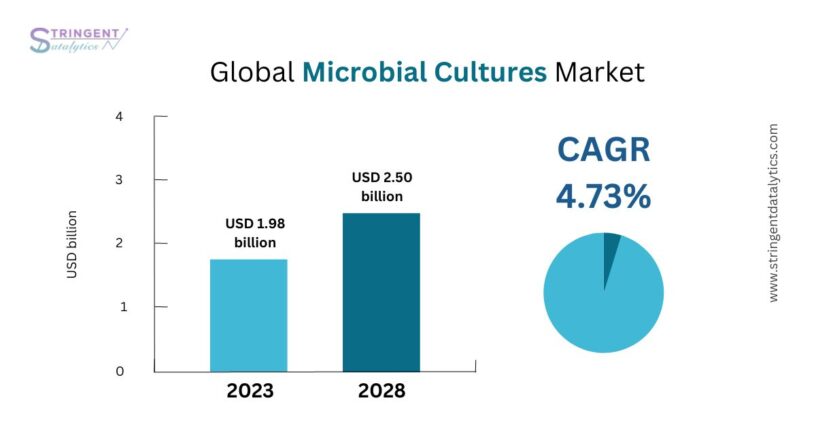Microbial Cultures Market size is estimated at USD 1,982.73 million in 2023, and is expected to reach USD 2,498.15 million by 2028, growing at a CAGR of 4.73% during the forecast period (2023-2028). The microbial culture market refers to the industry involved in the production and distribution of microorganisms for various applications. Microbial cultures are collections of microorganisms, such as bacteria, fungi, yeasts, and viruses, that are grown and maintained under controlled laboratory conditions. These cultures serve as valuable tools for research, industrial processes, and commercial production in diverse fields, including pharmaceuticals, agriculture, food and beverage, environmental testing, and biotechnology.
Microbial cultures are utilized for a wide range of purposes, including studying microbial physiology, conducting genetic research, developing new drugs and vaccines, manufacturing enzymes and bioactive compounds, and testing the safety and quality of products. These cultures are typically grown in a nutrient-rich medium that provides the necessary conditions for their growth and reproduction. The microbial culture market has witnessed significant growth in recent years due to advancements in microbiology, increasing demand for microbial-based products, and the rising emphasis on sustainable and eco-friendly solutions. With the expanding applications of microorganisms in various industries, the demand for high-quality and diverse microbial cultures has surged.
Growing Demand for Probiotics: Probiotics, which are beneficial live microbial cultures, have gained significant popularity due to their potential health benefits. The increasing consumer awareness of the gut microbiota’s role in overall health and well-being has led to a surge in demand for probiotic products. This trend has positively impacted the microbial cultures market.
Expanding Applications in Various Industries: Microbial cultures find applications across multiple industries, including food and beverages, pharmaceuticals, agriculture, and wastewater treatment. There has been an increased focus on using microbial cultures for food fermentation, biofertilizers, animal feed additives, and bioremediation. This diversification of applications has contributed to the market’s growth.
Technological Advancements: Advances in biotechnology, genetic engineering, and microbial screening techniques have facilitated the development of novel microbial cultures with enhanced properties. Researchers are focusing on improving the efficacy and specificity of microbial cultures to meet the demands of various industries. These technological advancements have opened up new opportunities in the microbial cultures market.
Shift Towards Natural and Organic Products: With the growing consumer preference for natural and organic products, there has been an increased demand for microbial cultures as natural preservatives, flavor enhancers, and functional ingredients. Microbial cultures offer a sustainable alternative to synthetic additives, driving their adoption in the food and beverage industry.
Rising Investments in Research and Development: Many companies operating in the microbial cultures market are investing in research and development activities to develop innovative and high-performance products. The aim is to differentiate themselves in the market by offering unique and customized solutions. Increased R&D investments have led to the introduction of advanced microbial cultures with improved functionalities.
Click Here, To Get Free Sample Report: https://stringentdatalytics.com/sample-request/microbial-cultures-market/11895/
Market Segmentations:
Global Microbial Cultures Market: By Company
• Chr. Hansen
• DuPont
• DSM
• Evonik
• HiMedia
• Ingredion
• Kerry Group
• Naturex
• Neogen
• NCIMB
Global Microbial Cultures Market: By Type
• Starter Cultures
• Adjunct & Aroma Cultures
• Probiotics
• Others
Global Microbial Cultures Market: By Application
• Bakery & Confectionery
• Dairy
• Fruits and Vegetables
• Beverages
• Others
Global Microbial Cultures Market: Regional Analysis
The regional analysis of the global Microbial Cultures market provides insights into the market’s performance across different regions of the world. The analysis is based on recent and future trends and includes market forecast for the prediction period. The countries covered in the regional analysis of the Microbial Cultures market report are as follows:
North America: The North America region includes the U.S., Canada, and Mexico. The U.S. is the largest market for Microbial Cultures in this region, followed by Canada and Mexico. The market growth in this region is primarily driven by the presence of key market players and the increasing demand for the product.
Europe: The Europe region includes Germany, France, U.K., Russia, Italy, Spain, Turkey, Netherlands, Switzerland, Belgium, and Rest of Europe. Germany is the largest market for Microbial Cultures in this region, followed by the U.K. and France. The market growth in this region is driven by the increasing demand for the product in the automotive and aerospace sectors.
Asia-Pacific: The Asia-Pacific region includes Singapore, Malaysia, Australia, Thailand, Indonesia, Philippines, China, Japan, India, South Korea, and Rest of Asia-Pacific. China is the largest market for Microbial Cultures in this region, followed by Japan and India. The market growth in this region is driven by the increasing adoption of the product in various end-use industries, such as automotive, aerospace, and construction.
Middle East and Africa: The Middle East and Africa region includes Saudi Arabia, U.A.E, South Africa, Egypt, Israel, and Rest of Middle East and Africa. The market growth in this region is driven by the increasing demand for the product in the aerospace and defense sectors.
South America: The South America region includes Argentina, Brazil, and Rest of South America. Brazil is the largest market for Microbial Cultures in this region, followed by Argentina. The market growth in this region is primarily driven by the increasing demand for the product in the automotive sector.
Visit Report Page for More Details: https://stringentdatalytics.com/reports/microbial-cultures-market/11895/
Objectives of Microbial Cultures Market Study:
- Market Size and Growth: Determine the current size of the microbial cultures market and forecast its future growth potential. This objective involves analyzing historical data, market trends, and factors influencing market growth, such as technological advancements, research and development activities, and regulatory frameworks.
- Competitive Analysis: Assess the competitive landscape of the microbial cultures market by identifying key players, their market share, and their strategies. This objective involves analyzing factors such as product portfolio, pricing strategies, distribution channels, partnerships, and mergers and acquisitions. Understanding the competitive environment helps stakeholders to identify opportunities, make informed business decisions, and formulate effective market entry or expansion strategies.
- Market Trends and Drivers: Identify the key trends, drivers, and challenges shaping the microbial cultures market. This objective involves analyzing factors such as consumer preferences, technological advancements, regulatory policies, and industry-specific trends. Understanding these dynamics helps stakeholders anticipate market changes, identify growth opportunities, and mitigate potential risks.
- Customer Insights: Gain insights into customer preferences, needs, and purchasing behavior related to microbial cultures. This objective involves conducting surveys, interviews, or focus groups with end-users, such as food and beverage manufacturers, pharmaceutical companies, and research institutions. Understanding customer requirements helps companies develop products that cater to market demands and gain a competitive edge.
- Market Entry Strategies: Provide guidance to new entrants or existing players seeking to enter or expand their presence in the microbial cultures market. This objective involves analyzing market barriers, entry strategies, distribution channels, and investment opportunities. It helps stakeholders make informed decisions regarding product development, marketing, and distribution, considering the competitive landscape and market dynamics.
- Regulatory Landscape: Assess the regulatory framework governing the microbial cultures market. This objective involves understanding relevant regulations, standards, and certifications that impact the manufacturing, distribution, and use of microbial cultures. Compliance with regulatory requirements is crucial for companies operating in the market and ensures product safety, quality, and legality.
- Investment Opportunities: Identify investment opportunities in the microbial cultures market for stakeholders, including investors, venture capitalists, and strategic partners. This objective involves analyzing market trends, growth potential, and competitive landscape to identify promising areas for investment, such as emerging applications, geographic markets, or innovative technologies.
About US:
Stringent Datalytics offers both custom and syndicated market research reports. Custom market research reports are tailored to a specific client’s needs and requirements. These reports provide unique insights into a particular industry or market segment and can help businesses make informed decisions about their strategies and operations.
Syndicated market research reports, on the other hand, are pre-existing reports that are available for purchase by multiple clients. These reports are often produced on a regular basis, such as annually or quarterly, and cover a broad range of industries and market segments. Syndicated reports provide clients with insights into industry trends, market sizes, and competitive landscapes. By offering both custom and syndicated reports, Stringent Datalytics can provide clients with a range of market research solutions that can be customized to their specific needs.
Contact US:
Stringent Datalytics
Contact No – +1 346 666 6655
Email Id – sales@stringentdatalytics.com




Leave a Reply